Image Scan! for Linux Manual
Last modified : 2015.10.20
A table of contents
1. End User License Agreement (Terms of Use)
2. Overview
3. Support
4. Supported Devices
5. Notes/Limitations
6. Usage Information
6.1. Installing the software
6.1.1. Auto installation in script
6.1.2. Installation in command
6.1.3. Installation the package manager
6.1.4. Notes for installation
6.2. Deletion of Software
6.3. Overview on Scanning
6.4. Running Image Scan! for Linux
6.4.1. From the command line
6.4.2. From the GIMP graphic software
6.4.3. From menu
6.4.4. Scan Selector dialog box
6.5. Main Window
6.6. Scanning an Image
6.6.1. Scanning to a File
6.6.2. Scanning to a Printer
7. Configuring SANE Network
7.1. Setting Up the Client
7.2. Setting Up the Server
7.3. Troubleshooting
7.3.1. The sane service
7.3.2. firewall
7.3.3. TCP wrappers
7.3.4. host name resolution
8. Setting Network Plug-in
8.1. Installing Network Plug-in
8.2. Uninstalling Network Plug-in
8.3. Setting Network Plug-in
9. Support distribution list
1. End User License Agreement (Terms of Use)
Image Scan! for Linux contains sources covered by the following licenses:
■ GNU General Public License
■ GNU Lesser General Public License
■ AVASYS Public License
Seiko Epson Corporation reserves the copyright of the binary files which are included in the sources.
These binary files are distributed under SEIKO EPSON CORPORATION SOFTWARE LICENSE AGREEMENT.
This software is distributed free of charge and without warranty.
Seiko Epson Corporation won't be held liable for any loss or damages that may be incurred as a result of the use of this software.
Image Scan! for Linux provides a graphical user-interface to directly control all of the features of your Epson scanner.
With this software you can scan images in color or black and white and obtain professional quality results.
In addition, Image Scan! for Linux supports network usage, and can also control a scanner that is connected to a computer on the network.
In this manual, a computer running Image Scan! for Linux is called “the client”,
and the computer that is connected to the scanner is called “the server”.
There is no official support provided for this software.
- For information regarding scanenr hardware, repairs and replacement parts, please contact your local Epson dealer.
- Epson Scanner
- Epson Multi Function Printer
- The SANE package version 1.0.3 or later must be installed before installing Image Scan! for Linux.
- This guide contains information on using Image Scan! for Linux.
For information about your scanner, see the manual shipped with your scanner. - Some screen shots in this guide may be different from yours.
Thisdifference does not change the instructions. - Commands are indicated in fixed width font.
Please install in one of the following ways the downloaded package.
6.1.1. Auto Installation in script
Please run the script (install.sh) included in the downloaded package from terminal.
# ./install.sh
If you cannot install correctly by specifying install script, please refer “README” included in the script.
Also, you can confirm the brief description by specifying the command as below.
# ./install.sh --help
6.1.2. Installation in command
If you installed in command, you must install multiple packages.
Open Terminal, then install the packages in the described order then from the command line.
Note: The following commands needs to be performed as a root privilege.
[RPM]
- Installing data package
- Installing core package
- Installing plug-in package (if provided)
- Installing image processing plug-in package(optional)
# rpm --upgrade iscan-data-$ver-$rel.noarch.rpm
# rpm --upgrade iscan-$ver-$rel.$arch.rpm
# rpm --upgrade iscan-plugin-$scanner-$ver-$rel.$arch.rpm
or# rpm --upgrade esci-interpreter-$scanner-$ver-$rel.$arch.rpm
# rpm --upgrade iscan-plugin-esdip-$version-$release.rpm
[DEB]
- Installing data package
- Installing core package
- Installing plug-in package (if provided)
- Installing image processing plug-in package(optional)
# dpkg --install iscan-data_$ver-$rel_all.deb
# dpkg --install iscan_$ver-$rel_$arch.deb
# dpkg --install iscan-plugin-$scanner_$ver-$rel_$arch.deb
or# dpkg --install esci-interpreter-$scanner_$ver-$rel_$arch.deb
# dpkg --install iscan-plugin-esdip-$version-$release.deb
Abbreviations used for package representations mean as follows:
$ver : package version
$rel : package release number
$arch : package architecture
6.1.3. Installation the package manager
You can install the package of this driver software by using package manager.
Note: The following description may be different on your environment.
- Double-click the Image Scan! for Linux binary package icon to install it.
- If you can find install option by right clicking on the package icon that you have downloaed(.dev / .rpm), you can specify it.
Please run the package installation in the following order.
- data package
- core package
- plug-in package (if provided)
- image processing plug-in package(optional)
- If the message “error: failed dependencies” appears during installation of Image Scan! for Linux, quit the installation.
Install the necessary packages listed in the message, and then install Image Scan! for Linux again. - When using the scanner on the network, Image Scan! for Linux must be installed on both the server connected to a scanner and client computers.
Ref:「7. Configuring SANE Network」 - The SANE package version 1.0.3 or later must be installed before installing Image Scan! for Linux.
http://sane.alioth.debian.org/ - For help on installation of Debian and RPM binary packages, refer to your distribution’s documentation.
You can uninstall the package of this driver software by using package manager, etc.
Or you can also uninstall this software package by opening a terminal and using command lines input.
Note: The following commands needs to be performed as a root privilege.
[RPM]
- Uninstallation of Plugin package Note: Execute the following command only if you installed plug-in package.
- Uninstallation of Image Processing package Note: Execute the following command only if you installed image processing plug-in package.
- Uninstallation of Core package
- Uninstallation of Data package
# rpm -e iscan-plugin-$scanner
or# rpm -e esci-interpreter-$scanner
# rpm -e iscan-plugin-esdip
# rpm -e iscan
# rpm -e iscan-data
[DEB]
- Uninstallation of Plugin package Note: Execute the following command only if you installed plug-in package.
- Uninstallation of Image Processing package Note: Execute the following command only if you installed image processing plug-in package.
- Uninstallation of Core package
- Uninstallation of Data package
# dpkg --remove iscan-plugin-$scanner
or# dpkg --remove esci-interpreter-$scanner
# dpkg --remove iscan-plugin-esdip
# dpkg --remove iscan
# dpkg --remove iscan-data
You can scan an image with Image Scan! for Linux using the following steps.
- Make sure the scanner and the computer connected to the scanner are turned on.
- Place a document on the scanner. See the user’s guide of the scanner.
- Run Image Scan! for Linux on your computer.
See “6.4. Running Image Scan! for Linux”. - If the Scan Selector dialog box appears, select the scanner from the list. Click OK.
The main window appears.
See “6.4.4. Scan Selector dialog box”. - On the Document tab, make settings such as document source, image type, and resolution.
See “Document Settings”. - Click the Preview button to preview the full page.
See “Preview button”. - Create a marquee of the image you want to scan.
See “Marquee”. - Make the color adjustment settings.
Click the Auto Exposure button to automatically activate and optimize the image enhancement for image source.
Or, click the Image Controls or Tone Correction tab, and then set the color adjustments as you prefer.
See “Image Controls” or “Tone Correction”. - Select a destination to send the scanned image.
You can either save a scanned image as a file or send it directly to a printer.
See “Destination list box (when in normal mode)”. - Click the Scan button. The scanned image is saved as a file or sent to the printer.
See “6.6. Scanning an Image”.
6.4. Running Image Scan! for Linux
You can start Image Scan! for Linux either from the command line or menu or through the GIMP.
At the command prompt, execute the following command to start Image Scan! for Linux.
$ iscan
Image Scan! for Linux starts. If more than one scanner are connected to the network, the Scan Selector dialog box appears.
See “6.4.4. Scan Selector dialog box”.
6.4.2. From the GIMP graphic software
You can also start Image Scan! for Linux from the GIMP.
In this case, the scanned image is transferred to the GIMP for further image manipulation instead of a file or printer.
As of version 1.15.0, iscan is automatically registered as a GIMP plugin if you install the binary package.
In case it didn't (because you built from source for example), you can register it yourself with the following command
$ ln -s /usr/bin/iscan ~/.gimp-2.2/plug-ins/
Adjust the version number to match the version of the GIMP that you use.
Once iscan is registered as a plug-in, you can start it via the entry in the Xtns menu under the Acquire Image section.
Select Create from the File menu of GIMP, and then select Scanning (iscan).
Note: The menu configuration may differ depending on which version of GIMP that Image Scan! for Linux starts.
If more than one scanner is connected to the network, the Scan Selector dialog box appears.
Select the icon of "Image Scan! for Linux" in the menu.
6.4.4. Scan Selector dialog box
If more than one scanner are connected to the network, the Scan Selector dialog box appears when you run Image Scan! for Linux.
Select a scanner you want to use, and then click OK.

The main window allows you to make the following settings.
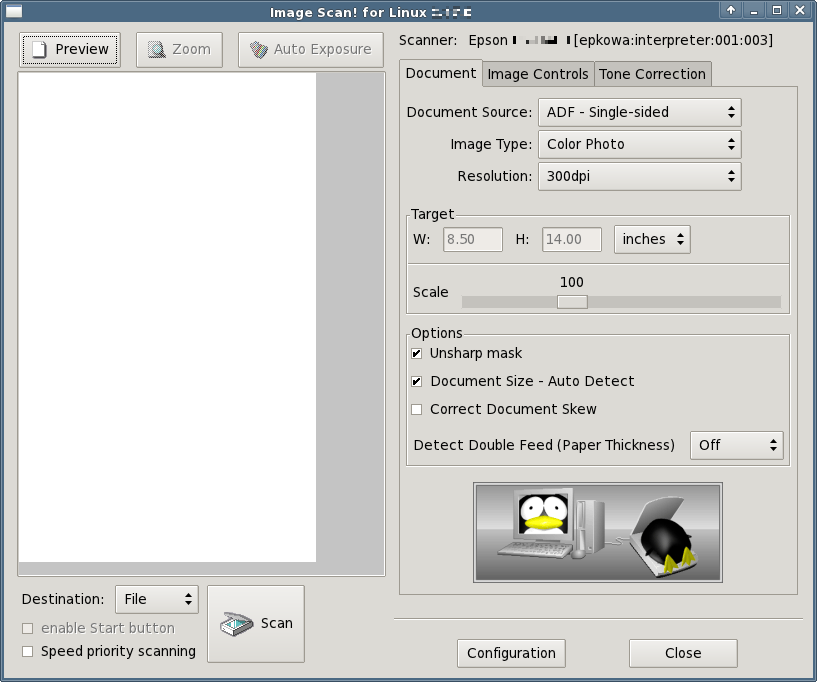
When the height of the computer screen is 767 pixels or less, the main window of compact GUI mode appears.
The functions are the same as for normal mode, but the operating procedures and screen configuration differ.
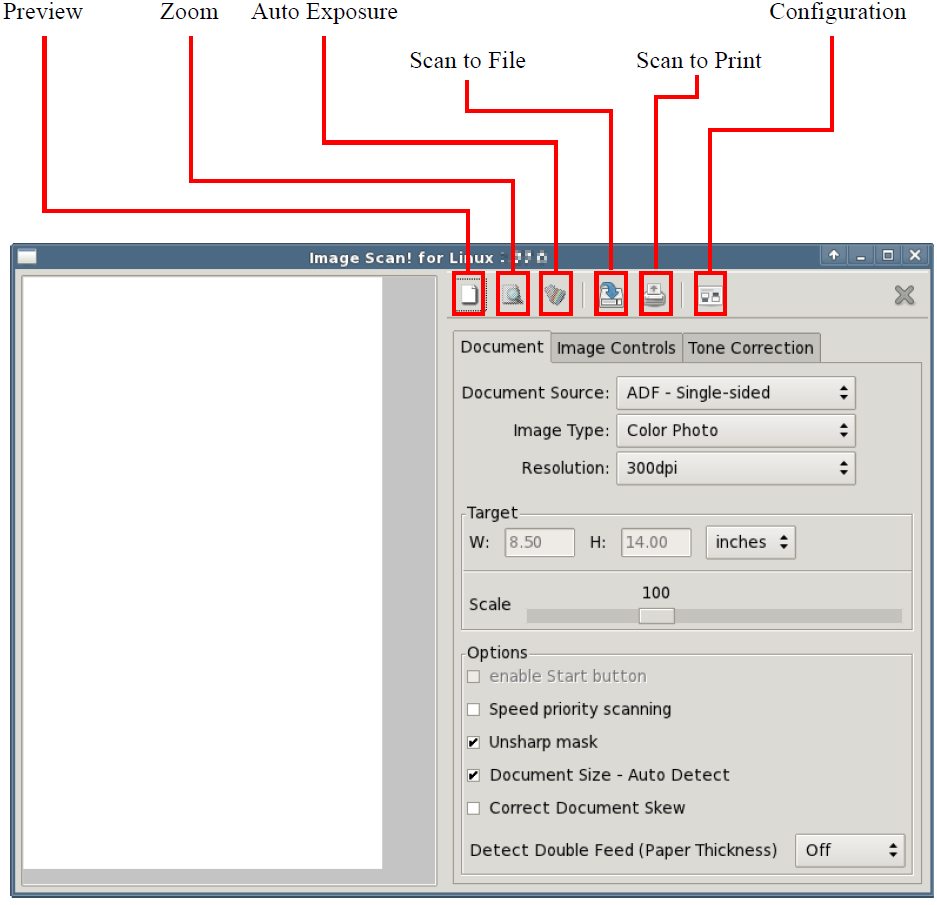
-
Before you scan an image, you can use the Preview window to see the effects of most Image Scan! for Linux settings, and to make additional image adjustments.
Image Scan! for Linux can automatically adjust and optimize the exposures and colors of scanned images during previewing.
You can also use a marquee (frame) to scan only selected area of an image.
-
A marquee is a sizeable frame that determines what part and how much of an image will be scanned.
To create a marquee, move the pointer over the image in the Preview window.
The pointer becomes a set of cross-hairs.
Hold down the mouse button and drag the cross-hairs over an area of the image, then release the mouse button to create a marquee.
To move the marquee, place the mouse pointer within the marquee, and drag the marquee anywhere in the Preview window.
To resize the marquee, place the mouse pointer on the edge of the marquee and drag an arrow.
To delete the marquee, click the Preview window.
Zoom button
-
Click the Zoom button to zoom in on a selected area of the image.
Use a marquee to select the part of the image you want to zoom and then click this button.
※The Zoom button is dimmed if there is no preview image or no marquee in the preview window.
Auto Exposure button
-
Click the Auto Exposure button to automatically optimize the exposure for an image.
The Gamma, Highlight, and Shadow settings in the Image Controls dialog box are automatically set.
※The Auto Exposure button is dimmed if there is no preview image or if Line Art is selected for Image Type.
Scanner
-
Displays the scanner name you have selected.
If you want to use a different scanner on the network, you need to quit Image Scan! for Linux and then run it again.
Then select the scanner in the Scan Selector dialog box.
※The scanner name is not displayed in compact GUI mode.
Destination list box (when in normal mode)
-
You can specify where the scanned image is to be sent: either File or Printer.
When you select Printer, the scanned image is sent to the default printer.
If you want to use a different printer, click the Configuration button to specify the printer.
※If you start Image Scan! for Linux from the GIMP, this setting is dimmed.
Scan to Print (when in compact GUI mode)
-
Click the Scan to Print button to scan and print the image.
Printing is performed with the printer registered as the default printer.
If you want to use another printer for printing, click the Configuration button and specify the printer.
Start Button check box
-
When you check this box, the scanner will not perform a scan until you press the Start Button of your scanner.
This is convenient if your scanner is, for example, located in another room, or you want to make several scans in a row
(not unlike what happens when scanning from an ADF unit).
※For scanners that do not support the Start Button, this check box is not displayed.
※In compact GUI mode, this check box is displayed in the Document tab.
Speed priority scanning
-
Select this check box when scanning speed is more important than image quality.
※When your scanner does not support this function, the scanning speed will not change.
※In compact GUI mode, this check box is displayed in the Document tab.
Scan button (when in normal mode)
-
Click the Scan button to start scanning. For detailed information,
see “6.6.1. Scanning to a File”.
Scan to File (when in compact GUI mode)
-
Click the Scan to File button to save the scanned image to file.
After you click this button, select the save directory and file name, and then start scanning.
For detailed information, see “6.6.1. Scanning to a File”.
Configuration button
-
When you select Printer for the destination, the scanned image is sent to the default printer.
If you want to use a different printer, click the Configuration button to specify the printer.
Print Command
Specify a print command (up to 256 characters).
When using an Epson printer, we recommend you install Photo Image Print System for high quality printing.
Your print system needs to be able to handle the PNG format.
Both the Common Unix Print System (CUPS) and Photo Image Print System, versions 1.3.1 and later, do this by default.
※If you start Image Scan! for Linux from the GIMP, the Configuration button is dimmed.
-
In the Document dialog box, you can make settings such as document source, image type, and output resolution.
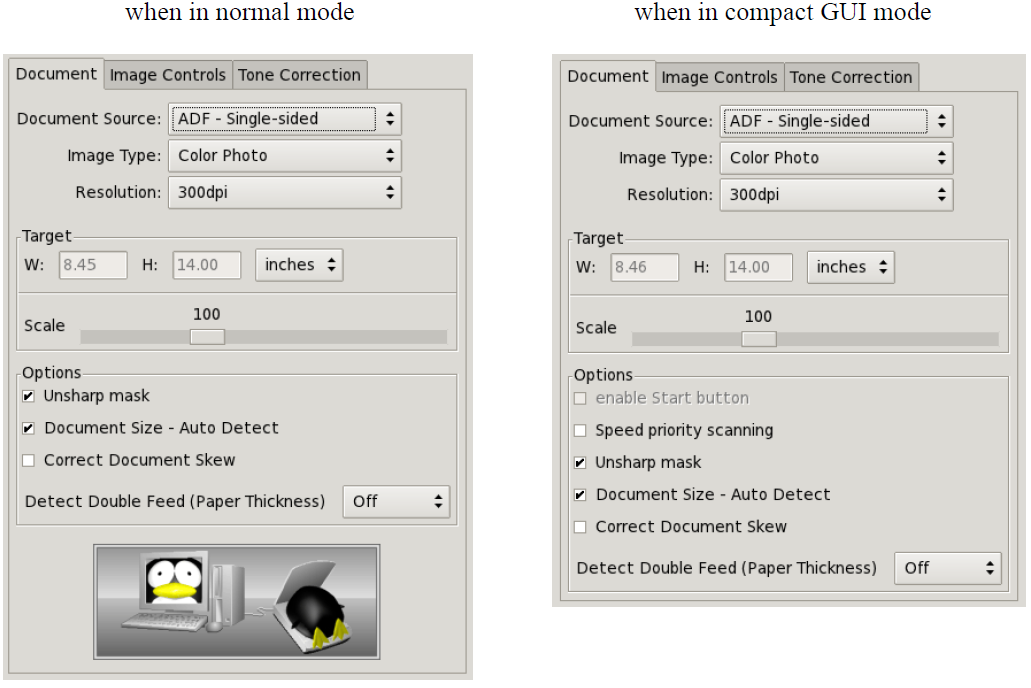
[Document Source]
The Document Source list contains the following settings: Flatbed, TPU for Neg.Film, TPU for Pos.Film, ADF - Single-sided, and ADF - Double-sided.When scanning a reflective document placed on the document table of the scanner, leave Document Source set to Flatbed.
Flatbed :
Select Flatbed to scan reflective document.
TPU for Neg.Film/TPU for Pos.Film :
Select one of them depending on the type of film (negative or positive) you are scanning.
Select TPU for Neg.Film for negative film and TPU for Pos.Film for positive film.
ADF - Single-sided :
Select ADF - Single-sided when using the ADF (Auto Document Feeder) to load your documents and scan only one side of your document pages.
ADF - Double-sided :
Select ADF - Double-sided when using the ADF (Auto Document Feeder) to load your documents and scan both sides of your document pages.
※TPU for Neg.Film and TPU for Pos.Film are disabled if Transparency Unit is not connected to your scanner.
※ADF - Single-sided and ADF - Double-sided do not appear if Automatic Document Feeder is not connected to your scanner.
If you are using a scanner that does not support the ADF - Doublesided function, you cannot select ADF - Double-sided.
[Image Type]
The Image Type list contains the following settings: Color Photo, Color Document, Black & White Photo, Black & White Document, and Line Art.Color Photo :
24-bit color
This setting is useful when scanning color photos.
Color Document :
24-bit color
This setting is useful when scanning magazines or catalogs in color.
Black & White Photo :
8-bit gray
This setting is useful when scanning black and white photos.
Black & White Document :
8-bit gray
This setting is useful when scanning magazines or catalog in black and white.
Line Art :
Black and white
This setting is useful when scanning characters-only documents or line drawings without coloring.
※If Document Source is TPU for Neg.Film or TPU for Pos.Film, Line Art is dimmed.
[Resolution]
Resolution is the indication of how finely an image is resolved into pixels.It can be measured in dots per inch (dpi).
When you specify a high resolution, the number of pixels of the data increases and the scanned image becomes fine in texture.
Increasing the resolution causes the data size to increase. Specify a suitable resolution according to the scanning purpose.
※The range of resolution depends on your scanner.
[Target]
W (width) and H (height) :You can confirm the size of the output image.
The width and height appear in the selected unit of measurement.
You can change the image area in the Preview window by creating a marquee.
Units :
Select a unit of measurement: inches, pixels, or cm.
[Scale slider]
An image can be reduced or enlarged by moving the scale slider.The range of possible reduction or enlargement varies depending on the current resolution.
[Unsharp mask check box]
You can improve the sharpness of an image by selecting the Unsharp mask check box.※If Image Type is Line Art, this check box is dimmed.
[Document Size - Auto Detect]
This setting automatically determines the size of your documents and scans them in an appropriate size.When this check box is selected, the size that you specify in the Preview window will be ignored.
※This check box is dimmed if your scanner does not support this function or when using TPU for the document source.
[Correct Document Skew]
Detects the skew of the original images and corrects them.Up to 25 degrees of skew can be corrected. This function is not effective for an over-skewed document.
[Focus]
You can specify the focus position.The default focus position with a flatbed document source is 0.0 and the TPU document source is 2.5.
※The focus setting appears for scanners that have an adjustable focusing mechanism.
[Detect Double Feed (Paper Thickness)]
This function stops scanning if a double feed occurs.To enable the Detect Double Feed function, select the paper thickness from Standard/Thin.
To disable the Detect Double Feed function, select Off.
※The Detect Double Feed (Paper Thickness) option only appears when using a scanner that supports the function.
※If the Detect Double Feed function does not work correctly, select Standard or Thin depending on the situation below.
Standard :
Select this option when the sheets are fed correctly but scanning stops while Thin is selected.
Thin :
Select this option when a double feed occurs but scanning does not stop while Standard is selected.
※The scanned file data is deleted if scanning to multiple page file is stopped by the Detect Double Feed function.
You will need to reload all the sheets and try again.
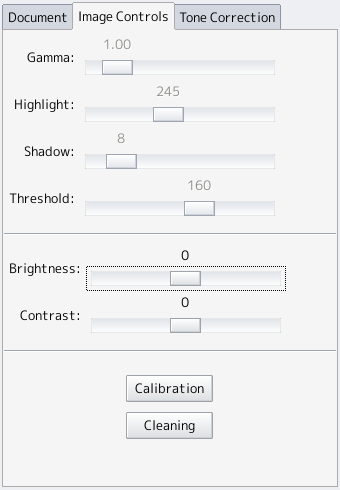
[Gamma]
Gamma is the difference in contrast between the light tones and dark tones of an image.Changes in the gamma level only affect mid-tones, and can be effective for bringing out details normally hidden in shadow or highlight.
To change the values, move the slider left or right.
When Image Type is Line Art, the Gamma control is dimmed.
[Highlight]
You can adjust the brightness in the lighter parts of an image.If the value is decreased, the image becomes brighter; if the value is increased, the image becomes darker.
To change the values, move the slider left or right.
When Image Type is Line Art, the Highlight control is dimmed.
[Shadow]
You can adjust the darkness in the darker parts of an image.If the value is decreased, the image becomes brighter; if the value is increased, the image becomes darker.
To change the values, move the slider left or right.
When Image Type is Line Art, the Shadow control is dimmed.
[Threshold]
You can adjust the threshold value of an image.The threshold is what allows the scanner to distinguish between an image and its background.
Since the best threshold depends on the document condition, find the best value by moving the slider left or right.
When Image Type is Color Photo or Black & White Photo, the Threshold control is dimmed.
※If there is no preview image, the Gamma, Highlight, Shadow and Threshold settings are dimmed.
[Brightness]
You can adjust the brightest areas of an image.This adjusts the whole image without affecting the contrast setting.
[Contrast]
You can adjust the difference in contrast between the bright parts and dark parts of an image.A higher contrast makes the bright parts become brighter and the dark parts darker,
while a lower contrast reduces the difference between the bright and dark parts.
※When there is preview image, the Brightness and Contrast control is dimmed.
[Calibration]
Performs color matching to make sure that the document's color tones are scanned correctly.Perform calibration in the following situations.
- If the color tone or clarity of the original document and the scanned results differ.
- If vertical lines appear in the scanned results.
See the scanner's User's Guide for more information on performing calibration.
The Calibration only appears when using a scanner that supports the function.
[Cleaning]
Cleans the scanners reading section.Perform cleaning if you notice any dirt or rubbish in the scanning results, or if the paper is not fed correctly.
See the scanner's User's Guide for more information on performing cleaning.
The Cleaning only appears when using a scanner that supports the function.
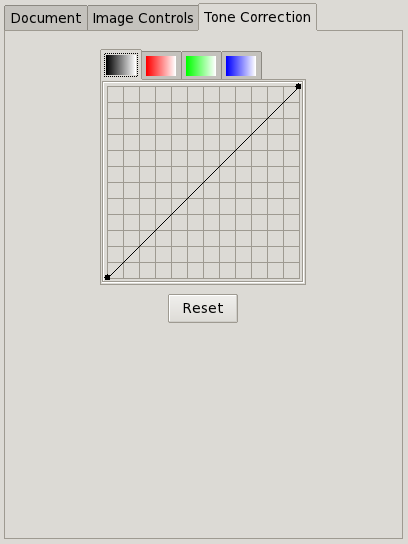
[Channel]
Click a colored button you want to adjust.When the left button next to the red/green/blue color set is selected, your adjustments affect all of the three colors.
Selecting one of the other buttons allows you to adjust red, green, or blue individually.
[Tone curve editor]
You can adjust the tone curve, which helps to ensure well-balanced coloring of the image.The tone curve editor allows you to change the shape of the tone curve.
The horizontal axis is the brightness of the original (input value), and the vertical axis is the brightness of the scanned image (output value).
The tone curve editor has two fixed points: (0, 0) and (255, 255).
In addition, you can create eleven fixed points inside the tone curve editor.
To create a fixed point, move the mouse pointer into the tone curve editor.
The pointer becomes a set of cross-hairs.
Click the location you want to select as the fixed point. The point you click becomes a new fixed point.
The black square appears on the fixed point, indicating that it is the current fixed point that you most recently adjusted.
When the mouse pointer is placed near the fixed point, it changes to an arrow allowing you to move the point.
Select the fixed point you want to move and then drag it.
To delete a fixed point, select it with an arrow.
Drag and drop the point out of the grid.
※If there is no preview image, all of the settings are dimmed.
[Reset button]
Click the Reset button to return the Tone Correction settings to their default values.
You can either save a scanned image as a file or send it directly to a printer.
To save a scanned image as a file, see “6.6.1. Scanning to a File”
to print a scanned image on a printer, see “6.6.2. Scanning to a Printer”.
When you select File in the Destination list box and then click the Scan button in the main window, the File Save Settings dialog box appears.
Use the File Save Settings dialog box to save a scanned image as a file.
You can specify an image format and a file name.
For scanning using the Automatic Document Feeder, you can name files with sequential numbers.
The default format is “default-###.pnm” where ### stands for sequential numbers set in the Start filling at list box and the Number of digits list box.
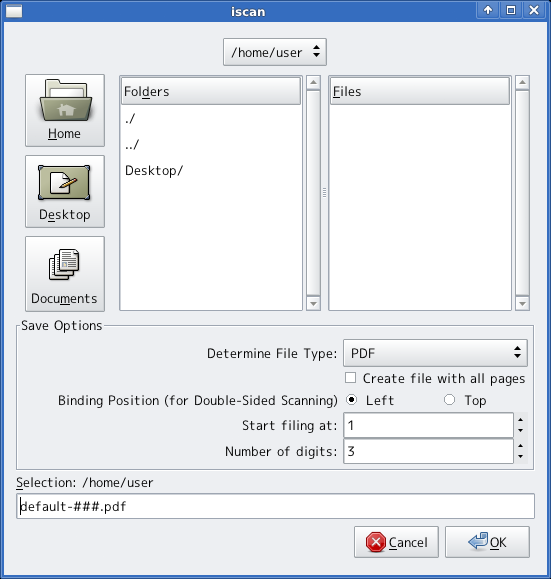
[Location]
Indicates the directories where image files are saved.[Determine File Type]
Select a file type to be saved, for example PNM, PNG, JPEG or PCX.[Create file with all pages]
When you select PDF or TIFF for the file format, you can save multiple pages to one file.If checked, the following two options will be disabled.
[Binding Position(for Double-Sided Scanning)]
When scanning both sides of the document, select the edge where the document is bound.You can select either Top or Left.
[Start filing at]
This menu appears if ADF is selected for the document source or the Start button is enabled.Specify a number to be added to the end of the file name.
The number will increase by one for each subsequent file.
[Number of digits]
This menu appears if ADF is selected for the document source.Specify the number of digits for the sequential number.
※The digit increases as the sequential number exceeds the number of digit.
For example, if the number of digits is set to 1 and the sequential number comes to 9,
the number of digits becomes 2 and the next sequential number becomes 10.
[Save file edit box]
Specify a file name for the scanned image.
You can send the scanned image to the printer specified in the Configuration dialog box.
Follow the steps below.
※To print the scanned image on an Epson printer,
we recommend you install Photo Image Print System Ver. 1.3.1 or later for high quality printing.
- Modify the settings as you prefer in the main window.
- Select Printer in the Destination list box.
- If you are not using the default printer, click the Configuration button and then enter the print command. Click OK.
- Click the Scan button. The scanned image is sent to the printer.
For example, if the printer name is scxxxx, enter lpr -Pscxxxx.
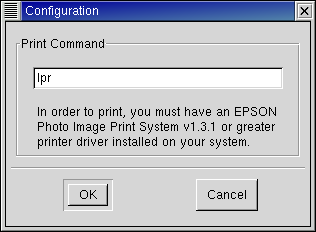
Image Scan! for Linux uses the SANE library to access your scanner(s).
This library contains a network module*1 that, with a little configuration, makes accessing scanners over the network a breeze.
This section explains how to get a network setup to work.
Here, a computer running Image Scan! for Linux is called “the client”, and the computer that is connected to the scanner is called “the server”*2.
For information on how to connect from Image Scan! for Linux to a scanner that is directly attached to the network, see “8. Setting Network Plug-in.”
*1 The SANE developers call this a backend, but other people may be more familiar with the term “driver”.
*2 It is very well possible that the client and the server refer to the one and the same computer.
On the client side, you need to check that the net module is enabled in /etc/sane.d/dll.conf and that the server(s) you want to use are listed in /etc/sane.d/net.conf.
Sample versions of the files may look like:
net
epkowa #needed by iscan
for a minimalistic network enabled dll.conf usable with iscan, and
scan-server
192.168.0.1
for a simple two server net.conf. Hosts can be specified by name or by IP address.
Both files are plain text files and can be edited with your favorite text editor.
You do need root permissions to do this, though.
For more detailed information about these files (and more), refer to the sane-dll(5) and sane-net(5) manual pages.
You also need a sane entry in /etc/services, but installing Image Scan! for Linux should have taken care of that.
The required entry looks like:
sane 6566/tcp # SANE network scanner daemon
You can easily find it with the following command:
$ grep 6566/tcp /etc/services
On the server side, you need to add the clients that are allowed to use the scanner(s) to the /etc/sane.d/saned.conf file.
A sample setup may look like:
scan-client
192.168.0.2
For detailed information about the saned.conf file (and more), refer to the saned(1) manual page.
The server's /etc/sane.d/dll.conf should have the epkowa module enabled.
Installation of Image Scan! for Linux adds this module and enables it by default.
Just as on the client, the server's /etc/services needs a sane entry.
Again, the installation of Image Scan! for Linux should have taken care of that.
The saned daemon (the program that handles all SANE network scan requests) is typically started and stopped via the internet super-server: inetd or xinetd. If your system uses inetd, you need to add a line like
sane stream tcp nowait root.root /usr/sbin/saned saned
to your /etc/inetd.conf file and restart the daemon.
This requires root privileges. Restarting is typically achieved via
# /etc/init.d/inetd restart
On xinetd based systems, you need to add a sane file in the /etc/xinetd.d/ directory and possibly tweak /etc/xinetd.conf.
A sample sane file is provided with Image Scan! for Linux in the documentation directory and looks like
# default: off
# description: sane network scanner daemon
service sane
{
disabled = no
port = 6566
socket_type = stream
wait = no
user = root
server = /usr/sbin/saned
}
Restart xinetd after adding the file.
Many factors play a role in networking and some of these may prevent your configuration from working.
Some of the more common, network related culprits are:
Although the SANE documentation refers to it as the sane service, the IANA has registered it as the sane-port service.
This means that your systems may only have a sane-port service in its /etc/services file.
This can wreck havoc on your network scanner setup.
To fix this, you can:
- add an alias to your /etc/services so the entry looks like
- modify your /etc/inetd.conf or /etc/xinetd.d/sane file to use the sane-port service instead of the sane service.
You may also have to adjust the /etc/hosts.allow and/or /etc/hosts.deny files (see below).
sane-port 6566/tcp sane # SANE network scanner daemon
and/or
Many distributions allow you to set up a packet filtering firewall during installation.
If this firewall rejects or drops network packets directed at port 6566, the port used by saned, you will not be able to contact the scan server.
Note that both the server and client need to accept packets on the input and output chains.
Another access control mechanism that may prevent you from accessing saned on the server is tcpd.
This wrapper utility decides access based on information in the /etc/hosts.allow and /etc/hosts.deny files.
Naturally, the server needs to allow the client and vice versa.
Refer to the hosts_access(5) manual page for details.
The saned daemon does reverse name lookups before it responds to scan requests.
This means that it checks whether host name and IP address match.
If your domain name service (DNS) server is slow to respond, misconfigured or temporarily unavailable,
reverse name lookups will fail and clients will not be allowed to connect.
This chapter explains how to set the connection from Image Scan! for Linux to a scanner that is directly attached to the network.
By using the network plug-in, you can connect to a scanner that is directly attached to the network.
Please note that scanning over the network is only supported in a client/server setup.
Scanners directly attached to the network are not supported.
8.1. Installing Network Plug-in
When installing the network plug-in, Image Scan! for Linux must be already installed.
In most graphical environments, just double-click the Image Scan! forLinux binary package icon to install it.
If this does not work for you, install it from the command line with the least common denominator tools using the following steps:
- Log in as a user with root privileges.
- Execute the following command to install the network plug-in.
- If you are not using the default printer, click the Configuration button and then enter the print command.
Click OK.
For Debian packages:
# dpkg --install iscan-network-nt-$version-$release.deb
For RPM packages:# rpm --upgrade iscan-network-nt-$version-$release.rpm
8.2. Uninstalling Network Plug-in
- Log in as a user with root privileges.
- Execute the following command to uninstall the network plug-in.
- If you are not using the default printer, click the Configuration button and then enter the print command.
Click OK.
For Debian packages:
# dpkg --remove iscan-network-nt
For RPM packages:# rpm -e iscan-network-nt
- Connect the scanner to the network and set the IP address.
For information on how to set the IP address, refer to the user manual shipped with your scanner. - Please enter the information on your scanner in /etc/sane.d/epkowa.conf by using root privileges.
- Start iscan. When starting, if it identifies the scanner on the network properly, it will work without any problems.
At this time, if multiple scanners are connected, the Scan Selector dialog box is displayed just like when connected locally.
See “6.4.4. Scan Selector dialog box”.
How to enter the information:
net [IP address] [port number]
ornet [host name] [port number]
Note: Please set [port number] to 1865.
Entering a port number is optional, so you can omit it.
However, you must enter an IP address port number.
Example:
If the IP address host name is set to 192.16.136.2 on your scanner, please add the following line in the file.
net 192.16.136.2 1865
The following is the list of support distributions.
[Red Hat system]
- Mandriva Linux 2009.1 or later[usb0.1+libltdl7]
- Fedora 11 or later
- openSUSE 11.1 or later
- SUSE Linux Enterprise 11
- PCLinuxOS 2010.07
- Redhat Enterprise Linux 6 or later
[Debian system]
- Ubuntu 8.10 or later[usb0.1+libltdl7]
- Linux Mint 6 or later
- Debian GNU/Linux 6.0 or later
Image Scan! for Linux has been designed as independent from the distribution.
Then, it should work on the distribution which is not listed in the above.
If it does not work, try to build from the source file on the distribution.